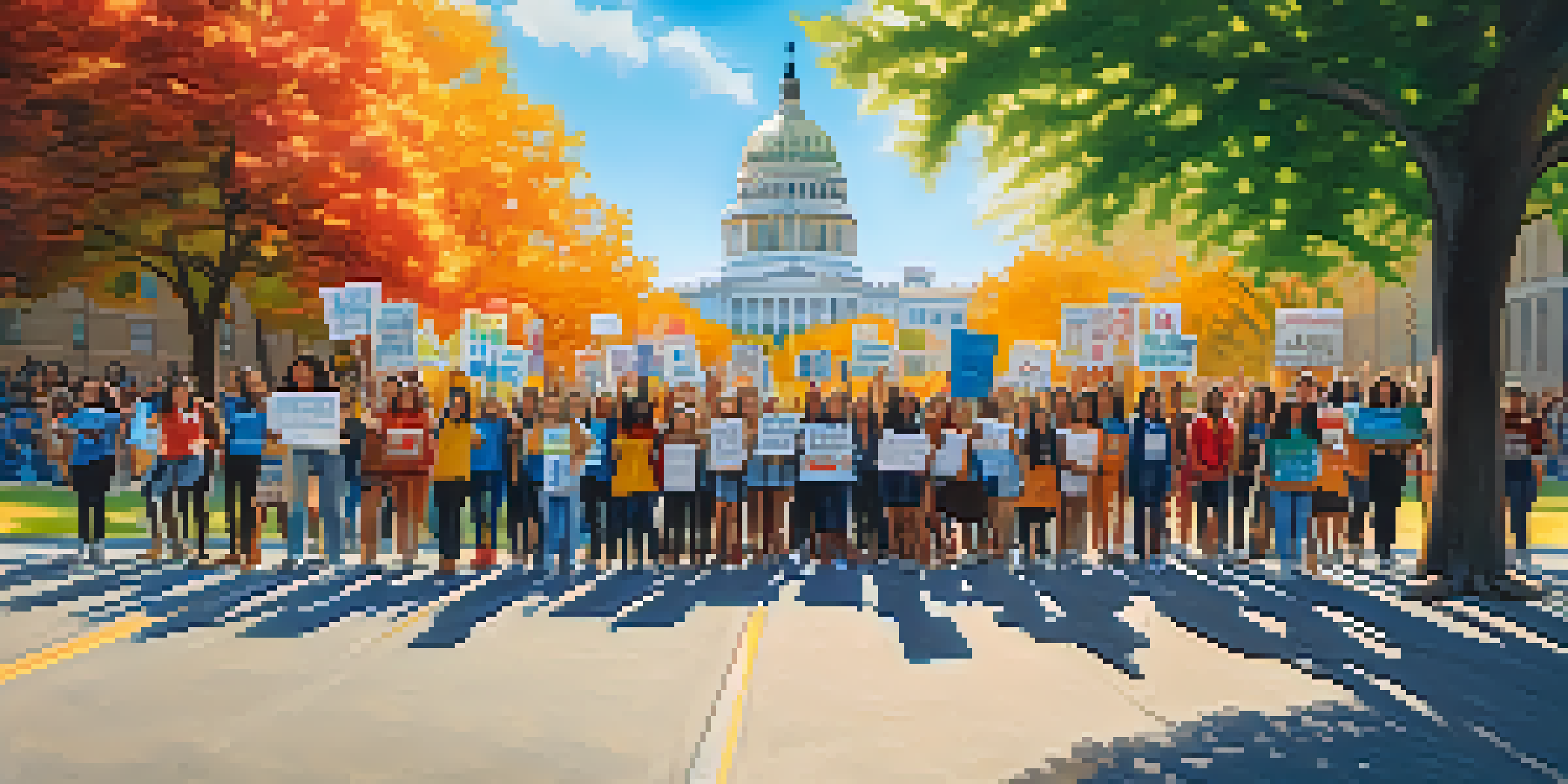Social Media as a Platform for Student Advocacy and Activism

The Rise of Social Media in Student Activism
In recent years, social media has transformed the landscape of student activism. Platforms like Twitter, Instagram, and TikTok allow students to share their voices and mobilize support quickly. Gone are the days when organizing a protest meant printing flyers and hitting the streets; now, a single tweet can reach thousands in an instant.
Social media is not just a tool for communication; it is a powerful platform for activism and change.
This immediacy creates a sense of urgency around social issues, allowing students to respond to current events as they unfold. Whether it's advocating for climate justice or rallying for mental health awareness, social media serves as a vital tool for connection and outreach. It’s not just about sharing news; it’s about building a community around shared values and goals.
Moreover, the visual nature of platforms like Instagram makes it easier to convey powerful messages through images and videos. These elements can evoke emotions and inspire action, making them essential for effective advocacy. Students can illustrate their points vividly, drawing in more followers and supporters along the way.
Building Community through Online Platforms
Social media fosters a sense of community among students who share common goals. Groups and pages dedicated to specific causes allow individuals to connect, share ideas, and strategize together. This online camaraderie can be especially uplifting for students feeling isolated or unheard in their offline environments.

For example, the #BlackLivesMatter movement gained significant traction through social media, uniting students and activists across the globe. By sharing personal stories and resources, they created a support network that transcended geographical boundaries. This sense of belonging can empower students to take action and advocate for change.
Social Media Empowers Student Activism
Platforms like Twitter and Instagram enable students to mobilize quickly and effectively around social issues.
In addition, online platforms provide a space for students to educate themselves and others. With access to diverse perspectives, they can engage in meaningful discussions and learn from one another. This collaborative learning enriches their advocacy efforts and enhances their understanding of the issues at hand.
Amplifying Voices: Social Media and Diverse Representation
One of the most powerful aspects of social media is its ability to amplify diverse voices. Students from marginalized communities can share their experiences and challenges, bringing attention to issues that might otherwise go unnoticed. This representation is crucial for fostering a more inclusive dialogue around advocacy.
The power of the people is greater than the people in power.
For instance, campaigns like #MeToo and #SayHerName have highlighted the struggles faced by women and people of color, creating a platform for their stories. By raising awareness and encouraging discussions about these topics, social media allows students to challenge the status quo and demand change. Everyone deserves to be heard, and social media provides that space.
Moreover, the global reach of social media means that these voices can resonate far beyond local communities. When students from different countries unite for a common cause, they can create a powerful, worldwide movement. This interconnectedness is a testament to the strength of social media in advocacy efforts.
Mobilizing Action: Organizing Events and Campaigns
Social media is not just a platform for discussion; it’s a powerful tool for mobilizing action. Students can quickly organize events like protests, workshops, or fundraisers, encouraging participation through shares and likes. The ease of spreading the word can significantly increase turnout and engagement.
For example, the March for Our Lives movement, initiated by students after the Parkland shooting, utilized social media to plan nationwide rallies. With creative posts and engaging content, they tapped into the youth’s desire for change, inspiring millions to join the cause. This demonstrates how effective social media can be in garnering support for meaningful actions.
Building Community Online
Social media fosters connections among students with shared goals, creating supportive networks that transcend geographical boundaries.
Additionally, social media allows for real-time updates during events, keeping participants informed and engaged. Whether it’s live-streaming a protest or sharing important announcements, students can ensure that everyone is on the same page. This level of coordination can lead to more impactful and organized advocacy efforts.
Challenges of Student Activism on Social Media
While social media offers many benefits for student activism, it also presents challenges. Misinformation can spread rapidly, leading to confusion and undermining genuine advocacy efforts. Students need to be vigilant about fact-checking before sharing information to maintain credibility.
Moreover, the pressure to maintain an online presence can be overwhelming. Many students may feel compelled to constantly engage with their audience, which can lead to burnout. It's essential for young activists to find a balance and prioritize self-care while still advocating for causes they care about.
Lastly, the online environment can sometimes foster negativity and hostility. Activists may face backlash or trolling, which can discourage them from speaking out. Building resilience and supporting one another in the face of such challenges is crucial for sustaining activism in the long run.
The Role of Influencers in Student Activism
Influencers have become significant players in the realm of social media activism. Many young people look up to these figures for inspiration and guidance, making them powerful allies in advocating for change. When influencers use their platforms to address important issues, they can mobilize their followers for collective action.
For instance, when popular figures endorse a cause or share personal experiences related to activism, they can inspire their audience to engage. This phenomenon can lead to increased awareness and participation in movements that may have previously gone unnoticed. Influencers help bridge the gap between celebrity culture and grassroots activism.
Challenges of Online Activism
Despite its benefits, social media activism faces challenges such as misinformation, burnout, and online hostility that activists must navigate.
However, it's essential for influencers to approach these topics authentically. Students are savvy consumers of content; they can tell when someone is being insincere. Genuine advocacy resonates more deeply than superficial gestures, and students appreciate when influencers truly commit to a cause.
Future of Student Advocacy on Social Media
Looking ahead, the potential for student advocacy on social media is immense. With advancements in technology and the continuous evolution of platforms, new ways to engage and mobilize will undoubtedly emerge. Students will continue to harness these tools to amplify their voices and advocate for the issues that matter most to them.
As younger generations become increasingly tech-savvy, they will likely push the boundaries of how social media is used for activism. From virtual reality events to interactive campaigns, the future holds exciting possibilities. This innovation will keep activism fresh and relevant, capturing the attention of both peers and decision-makers.

Ultimately, social media will remain a cornerstone of student activism, providing a space for connection, education, and action. As long as students continue to engage with these platforms responsibly and authentically, they will drive meaningful change in their communities and beyond.